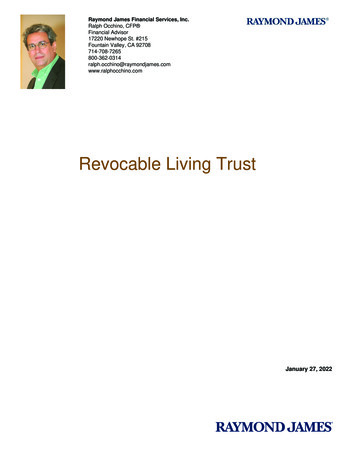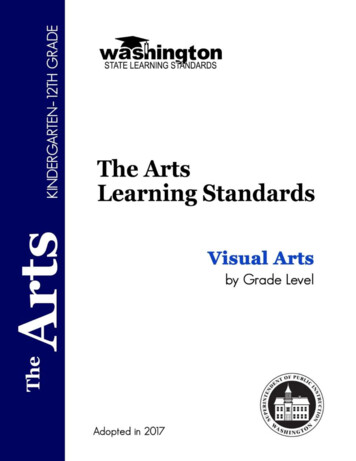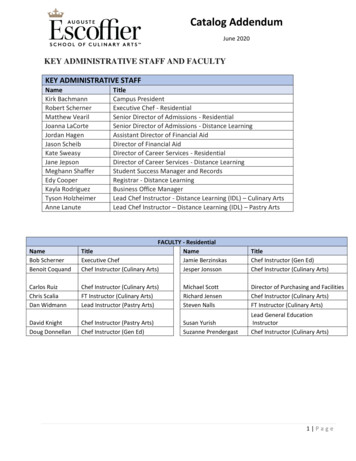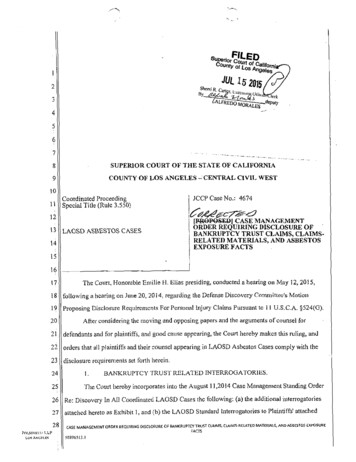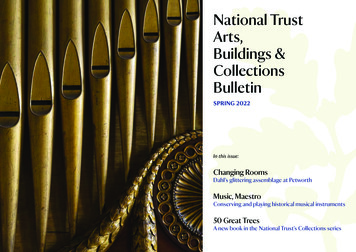
Transcription
National TrustArts,Buildings &CollectionsBulletinSPRING 2022In this issue:Changing RoomsDahl’s glittering assemblage at PetworthMusic, MaestroConserving and playing historical musical instruments50 Great TreesA new book in the National Trust’s Collections series1NATIONAL TRUST ABC BULLETIN SPRING 2022
ContentsPublished by the National Trust, Heelis,Kemble Drive, Swindon SN2 2NAPublisher: Christopher TinkerEditor: David BoultingConsulting Editors: Gabriella de la Rosa,Rupert Goulding and Sally-Anne Huxtable3ForewordTarnya Cooper4ABC Briefing: News, events and publications6The Many Faces of Petworth’s Beauty RoomRichard Ashbourne and James Rothwell12Publications: 50 Great Trees of the National TrustAndrew Jasper, Alison Pringle, Pamela Smith,Harry Whiting and Megan WheelerUnless otherwise stated, all measurements aregiven in the order: height, width, depth.17Magnum Opus: Andrew Garrett and the conservationof the National Trust’s musical instrument collectionsChristopher NobbsFront cover:Detail of chamber organ, 1765, James Gravenor(fl.1741–68), Kedleston Hall, Derbyshire (NT 108761)21Obituary: Andrew Garrett (1938–2021)Christopher Nobbs22Sounds Like Home: Hearing Erddig’s pastProfessor Jeanice Brooks and Dr Wiebke Thormählen25Photographing Sutton Hoo’s Ghost Ship: The remarkablerecord of Mercie Lack and Barbara WagstaffLaura Howarth29Out of Exile: A Gerrit Jensen mirror crestreturns to Knole’s ShowroomsSamantha Bailey33Loans: Selected highlights, 2022The Cultural Heritage Publishingprogramme is supported by a generousbequest from the late Mr and Mrs Kenneth Levy.Recent back issues can be accessed ctions-publicationsAlthough every effort has been made to ensurethat information in this publication is correctat the time of distribution, responsibility forerrors or omissions cannot be accepted by thepublishers or the contributors.Articles may not be reproduced or republishedwithout permission. National Trust 2022Photo: National Trust Images/Robert MorrisThis page and overleaf (top to bottom):Margaret Sawyer, Countess of Pembroke,1690–9, Michael Dahl (1659–1743),Petworth House, West Sussex (NT 486217)Photo: National Trust ImagesAncient beech, Plas Newydd, AngleseyPhoto: National Trust Images/James DobsonDouble-action ‘Gothic’ harp, 1843, Sebastian& Pierre Erard, London, Charlecote Park,Warwickshire (NT 533800)Photo: National Trust Images/Andreas von EinsiedelRecording for Sounding Erddig, Erddig, WrexhamPhoto: Jeanice BrooksExcavation of burial chamber, 1939, Mercie Lack(1894–1985), Sutton Hoo, Suffolk (NT 1940312.2.26)Photo: Original by Mercie Keer Lack ARPS Trusteesof the British Museum, digital image National Trust
ForewordWelcome to the spring issue of the National Trust’s research journal,Arts, Buildings & Collections Bulletin.In this issue we delve into the fascinating photographic archives documenting the discovery of SuttonHoo, consider the exciting exploratory conservation work to restore the late 17th-century ‘Beauty Room’at Petworth, and highlight the recent discovery at Knole of an 18th-century mirror crest.It feels extremely positive that, after the challenges we have all faced over the past two years,National Trust properties are now welcoming so many visitors, and that our research into historichouses, collections, gardens and the practice of conservation and engagement has restarted at pace.Over the course of the past year, we have benefited hugely from our supportive universitypartnerships, which work with curatorial, conservation, archaeological and horticultural staff acrossthe National Trust. Our partnership with the University of Oxford is developing collaborative researchfocussed on houses, collections and gardens, and a new partnership with University College Londonsupports conservation approaches across the historic environment. Elsewhere, we are working withthe universities of the GW4 Alliance (Bath, Bristol, Cardiff and Exeter) to develop property-basedprojects and have recently started working with Newcastle University in projects across the North.We also continue to work with the Jewish Country House project and keenly anticipate participationin the first major conference in June this year.We have also recently established a scheme of doctoral fellowships with the British Library, which willexplore authors’ houses and dispersed collections from National Trust houses. The outcomes of ourresearch projects and partnerships range from scholarly articles and books to conference contributionsand involvement in collaborative doctoral studies, including projects on pre-Reformation textiles andthe early histories of chocolate consumption.I’m also delighted that so much new research is being published in book format by the National Trust’sCultural Heritage Publishing team. Last year we published two books on our collections (125 Treasuresfrom the Collections of the National Trust and 100 Paintings from the Collections of the National Trust) andour forthcoming titles include: 50 Great Trees of the National Trust (April) by Simon Toomer; the firstarchaeological research monograph on Chedworth Roman Villa, written by 29 expert contributors (May,published in partnership with the Roman Society); and a major scholarly book on The Art of Tapestry byHelen Wyld (October, co-published with Bloomsbury).Finally, I am very pleased to say we will be relaunching this online magazine in autumn 2022 witha new title, National Trust Cultural Heritage Magazine, and a broader range of content. This will includeadditional articles on our living collections in gardens and parklands, updates on our collectionsand conservation projects, research initiatives and publications, and interviews with a wide rangeof staff. The new magazine will have the same research-based articles at its core, focussing on builtand cultivated heritage. We welcome any feedback or comments from existing readers on articles theywould like to see included (please email abc@nationaltrust.org.uk).Dr Tarnya CooperCuratorial and Conservation Director
ABC BriefingForthcoming:September 2022HardbackRRP 10224pp150 x 180mm978-0-70-780462-0News, events and publications100 Curiosities & Inventions fromthe Collections of the National TrustNational Trust sites across the UK23 April hThe National Trust cares for hundreds of trees that blossom in the spring, many of which are historical varieties.Visitors are invited to join in with the Trust’s celebration in the run up to #BlossomWatch day on 23 April bysharing their own pictures of beautiful blossom on social media.The blossom-watch web page (see above) includes a list of National Trust places to see stunning spring blossomaround the UK, as well as news of the Trust’s work to help communities blossom with greener spaces and circlesof blossom trees, and information about the importance of blossoming trees for nurturing wildlife.4NATIONAL TRUST ABC BULLETIN SPRING 2022Photo: City blossom, Cheltenham – National Trust Images/James Dobson#BlossomWatch DayThis beautifully illustrated book brings together a selection of 100surprising, unusual and wonderfully weird objects in the NationalTrust collections – one of the largest and most significant holdingsof fine-art and heritage objects in the world. It features forgottengadgets, imaginative inventions, humorous gifts and peculiarpersonal treasures. From dodos and dioramas to witch bottlesand wooden pets, all of these objects have stories to tell andthey provide unexpected insights into the lives of those whomade, owned or used them.In this forthcoming book from the National Trust’s CulturalHeritage Publishing programme, each object is accompanied bya wealth of images and an informative text. It concludes with agazetteer of places where these remarkable items can be found.The lead author, Katie Knowles, is Assistant National Curator forEngagement at the National Trust. She specialises in interpretationand has contributed to a range of publications on Trust collections.
Like many National Trust properties, Chedworth has more than one story to tell.This new research monograph, published by the Society for the Promotion of RomanStudies in association with the National Trust, provides an account of all the stagesof investigation, from the Victorian pioneers through to recent excavations. Writtenby 29 expert contributors led by Simon Esmonde Cleary, Jason Wood and EmmaDurham, it is the first comprehensive academic publication since the site’sdiscovery in 1864.It was a chance discovery by a gamekeeper in 1864 that led archaeologist JamesFarrer, uncle of landowner Lord Eldon, to begin the first excavations, and to build thelodge and museum that remain part of the site today. Chedworth was donated to theTrust in 1924, having been bought from the owner by public subscription. Some thingsabout Chedworth are unchanged over the centuries. Even in the 2nd century A.D.,although the landscape will have been very different, it would have had the same senseof remoteness that it has today. The modern visitor to Chedworth, finding the placeat the end of the winding Cotswold lanes, is greeted by a 21st-century visitor centreand conservation building, enabling visitors to see at close quarters the mosaic floors,hypocaust systems and bath house rooms of the west range.Published in the Britannia Monograph series, this important volume includesaccounts of the very latest research, techniques and emerging understanding,including specialist finds reports, laser survey and fabric analysis. Its assembly isa tribute to the National Trust’s commitment to the highest standards of researchand scholarship in the conservation of the historic sites it cares for.Constable RevealedPublished by the Roman Societyin association with the NationalTrust’s Cultural Heritage Publishingprogramme.Anglesey Abbey, Gardens & Lode Mill29 April–31 October 2022Pre-booking not required (by guided tour only in August)Online exhibition from 29 April, www.nationaltrustcollections.org.ukForthcoming: May 2022Paperback RRP 100608pp plus five fold-out elevationsOver 300 illustrations297 x 210mm978-0-90-776449-6John Constable’s largest ever canvas,Embarkation of George IV from Whitehall:The Opening of Waterloo Bridge, 1817 (NT 515574)has recently undergone 250 hours of conservationwork at the Royal Oak Foundation Studio at Knolein Kent. Conservation work has removed the thicklayer of discoloured, treacly brown varnish thatcovered the canvas. The improvements to thepainting’s appearance are so dramatic, it almostlooks like a different time of day or season. Thetexture of the paint surface and details can alsobe seen much more clearly. This project hasbeen funded by the Royal Oak Foundation andhas been undertaken by the National Trust’s firstRemedial Paintings Conservator, Sarah Maisey.To order, visit the Oxbow Bookswebsite:www.oxbowbooks.comOrder enquiries telephone: 44 (0) 1226 734350Also available from theNational Trust shop at ChedworthRoman Villa, GL54 3LJ5Photo: Conservation cleaning – National Trust Images/James DobsonChedworth Roman Villa research monographNATIONAL TRUST ABC BULLETIN SPRING 2022The painting’s return to AngleseyAbbey marks the start of an object trail,highlighting the property’s small butsignificant collection of Constables. The 1stLord Fairhaven (1896–1966) amassed a smallbut significant collection of Constable’sworks at Anglesey Abbey in the mid-20thcentury. This diverse group of paintingsshows the varied approaches Constablebrought to his art. They range from early oilpaintings of his native East Anglia, to a latewatercolour of Stoke Poges Church. Ongoingresearch, analysis and conservation of thislittle-known collection continues to revealnew dimensions of Constable’s practice.
The Many Facesof Petworth’sBeauty RoomRichard AshbourneAssistant Curator, London and South EastJames RothwellNational Curator, Decorative ArtsIn December 1703 at Petworth in Sussexa remarkable event took place in anextraordinary room. The Archduke Charlesof Austria, recognised as King of Spain byBritain and her allies, supped with PrinceGeorge of Denmark, Queen Anne’s consort,in what is now known as the Beauty Room(Fig. 1). This magnificent Baroque spacewas then hung with predominantly fulllength female portraits between a profusionof mirrors in which the glitteringassemblage, both real and painted,could be seen intermingling.There was no other room quite like it inEngland and few on such a scale even onthe Continent.1 It survived the vagaries offashion until the early 19th century,2 whenGeorge Wyndham, 3rd Earl of Egremont(1751–1837), who was struggling to house hisburgeoning picture and sculpture collection,decided to ‘cut off their legs’, reducingall the portraits to three-quarter lengthto make space for a shrine to the defeat6of Napoleon. Most of the mirrors wereremoved at the same time. And thus theroom remained until a request came fromTate Britain in early 2019 to borrow two ofthe portraits as highlights for the followingyear’s exhibition, British Baroque: Power andIllusion, provided they could be returned tofull-length. The request prompted a reevaluation of the significances of the room,and the commencement of the first phaseof a dramatic conservation and restorationcampaign that is still under way.Petworth House, the southern seat ofthe mighty Percy family, was transformedinto a Baroque palace by Charles Seymour,6th Duke of Somerset (the ‘Proud Duke’,1662–1748) and his heiress first wife, LadyElizabeth Percy (1667–1722). The work beganin 1688 and encompassed the creation ofthe stupendous west front (Fig. 2) – 320feet long – with a central hall and flankingapartments behind on the ground floorand, beyond them, a magnificent staircaseNATIONAL TRUST ABC BULLETIN SPRING 20221. The Beauty Room as it was in 2019, prior to the commencement of work to two of the BeautiesPhoto: National Trust Images/Andreas von Einsiedel
2. The principal façade of Petworth House,as transformed for the 6th Duke andDuchess of Somerset from 1688Photo: National Trust Images/Arnhel de Serra7that led to what was initially the principalapartment of state on the first floor, alsobehind the west front and culminatingin a gallery at the southern end. Archivalreferences and strong stylistic similaritiesto proven work in the Netherlands makeit highly probable that the designer wasthe Huguenot Daniel Marot (1661–1752),who had been brought over to England byWilliam III (r.1689–1702).3 As such, and givenits scale and the rate of survival, togetherwith the social and political significanceof the patrons, Petworth is one of Britain’smost important surviving buildings fromthe Baroque period.The Beauty Room was the great parlouror dining room of the Duke and Duchess’shouse, with a withdrawing room (now theWhite and Gold Room) and bedchamber(now the White Library) continuing theapartment to the south. It was also pivotalNATIONAL TRUST ABC BULLETIN SPRING 2022to the principal ceremonial route, leading tothe Grand Staircase and thus the first-floorstate apartment. The space was recordedas ‘Dining Room’ in the 1750 inventory ofPetworth 4 and in the Proud Duke’s will it isnoted as having a silver cistern ‘commonlyplaced on the floor before my Side Boardin that room at the usual times of Dinnersand Suppers’.5 A detailed account of theprotocol around the visit of the ArchdukeCharles, published in 1704, is a key source forunderstanding the planning and formal useof Baroque Petworth. Having been shownthe house by the Prince, who acted as host,the ‘King’ was taken to supper, which was serv’d up with so much Splendorand Profusion, and yet with so much Decencyand Order, that I must needs say I never saw thelike. The Table where they Supt was an Oval, andvery large, the King sat about the middle of it,and the Prince almost at the end. He [the King]Eat [sic] and Drank very heartily, but tasted noLiquors but his own, which were, the small Drink,Water discoloured by the infusion of Cinamon,and the strong, red and white Tyrol Wine. Whenhe calls for either of them, his Taster, who is alsoone of the Lords of his Bed Chamber, brings theLiquor in a little Bottle and covers it, or ratherhides it with a Salver, upon which he poursout what he Tasts, near as much as we call aSupernaculum. Then the King pours out what hepleases which is commonly a Glass Tumbler full,and drinks it off. The disposition of his Bread isas singular as anything else; for it is broke intovery small Mammocks, laid upon a Plate cover’dwith a Napkin and placed on his left Hand,from whence he takes it bit by bit, but keeps italways cover’d, I could not learn whether thiswas Custom or Superstition; and here it may notbe improper to tell you, that I believe he has anAversion for Dogs, because I observ’d one of hisNoblemen take up a Dog whilst the King Suptand with great Caution and Secrecy carry it outof the Room At Supper he was attended by allthe great Officers he brought over with him.6The principal feature of the Beauty Roomwas the series of eight portraits of lateStuart aristocratic women, six full-lengthand two three-quarter-length. All but oneare by Michael Dahl (1659–1743) and theirunusual proportions – they are very wideand the overdoors wider still – suggestthey were specifically painted for the room.Tabitha Barber, who curated the Tate show,is of the opinion that they are of 1695–6and the eighth picture, the Duchess ofMarlborough by Sir Godfrey Kneller, is dated1705.7 The Kneller perhaps supplanted a nowlost or unidentified Dahl as a consequenceof the heights to which the Duchess hadrisen, being Groom of the Stole, Mistressof Robes and Keeper of the Privy Purseto Queen Anne.
The first written record of the series isGeorge Vertue’s c.1730 description: ‘Dutchesof Marlborough. whole lenght [sic] Knellr. afine picture 6 whole lenghts Ladyes paintedby Mr. Dahl. beauties. these are very well &deserve the characters of the best works ofMr. Dahl.’ He omitted to note that two of thepictures were three-quarter-length but thisis confirmed in the 1748–50 inventory, whichlists ‘6 pictures of full length in panels’ and ‘2Do [ditto] in half length over the doors’.8The portraits were set into the panellingwith mirrors in between, while above all thefull-lengths except that over the fireplacewere paintings of cupids after Polidoro daCaravaggio. The arrangement must havebeen striking and it bears some similarity toMarot’s Audience Chamber of 1696–8 at TheHague and his late 17th-century interiorsat Heemstede, too, although in neitherof those cases is there an interspersing ofmirrors. In spite of later alterations it is clear8from the panelling how the various elementswere arranged, as has been illustrated byJames Finlay (Fig. 3).The room appears to have remainedbroadly in its original configuration untilthe 3rd Earl of Egremont decided to movehis shrine to the defeat of Napoleon fromwhat is now the Somerset Room but wasthen known as the Bonaparte Room.9 SirFrancis Chantrey, whose 1828 bust of theDuke of Wellington was the focus, alongsidea portrait of the vanquished Emperor byThomas Phillips, advised that the wallopposite the fireplace was the favouredlocation. Lord Egremont, rather thanremoving the full-lengths, is said to haveinstructed: ‘cut off their legs, I do not wanttheir petticoats; their heads shall be placedin three [sic] small panels above, and thebattles [Vittoria and Waterloo by GeorgeJones] with the marble bust of the Duke shallbe placed below.’10 It may well have been theNATIONAL TRUST ABC BULLETIN SPRING 2022Earl’s perpetual moving about of his picturesthat persuaded those executing his wishes tofold up the unwanted canvas at the back ofthe pictures rather than throwing it away.The Napoleonic scheme did, in the event,survive the Earl but was nevertheless shortlived, being dismantled after 1869 andonly re-instated in the 1990s as a holdingarrangement ‘pending the longer-termpossibility of restoring the paintings tofull-lengths and re-instating the 6th Duke’soriginal Beauty Room’.11 All the evidencesurvives to allow that to be undertaken,and following careful assessment ofcomparative significances and externaland internal consultation the decisionwas taken to proceed, commencing withthe two portraits for the Tate exhibition(Mary Somerset, Duchess of Ormonde andRachel Russell, Duchess of Devonshire), whichhave now returned to Petworth in theirmagnificent, restored state.3. Mock-up of the 18th-century Beauty Roomby James Finlay, showing how the variouselements were arrangedPhoto: National Trust/James Finlay4. The back of the Duchess of Ormonde,showing the folded bottom sectionPhoto: National Trust5. The back of the Duchess of Devonshire,showing the folded bottom sectionPhoto: National Trust
6. Conservator Jim Dimond restoring the Duchess of DevonshirePhoto: National Trust/Rah Petherbridge7. Chalk inscription found on the stretcher of the Duchess of Ormonde,signed ‘Edvardus Retentor’ and dated ‘1835’Photo: National Trust/Richard Ashbourne9NATIONAL TRUST ABC BULLETIN SPRING 2022The restoration and new findingsAt the outset of the project, a particularconcern was the state of the portionsof the pictures that had been cut off, reattached to the lining and folded up behind(Figs 4 and 5). However, examination byconservators revealed that, except for somesagging caused by a lack of tension, theywere in good condition, possibly becausethey had been kept in the dark for so longin what appear to have been relativelystable environmental conditions. Therewas very little difference in colour or texturebetween the bottom portions and therest of the paintings.As the restoration work began (withfunding support from Philip Mould &Company), previously hidden informationemerged (Fig. 6). The discovery of a chalkinscription on the Duchess of Ormonde’sstretcher provided new evidence for theproactive way in which the 3rd Earlmanaged his collection of paintings.It reads: ‘after they are lined All paintingsshould be painted at the backs EdvardusRetentor 1835’ (Fig. 7).‘Edvardus Retentor’ was identified byAndrew Loukes as the Latinised pseudonymof Edward Holder, who is known to haveworked at Petworth, including on thepicture collection, for the 3rd Earl from1833 to 1836. The inscription suggests thatHolder intended for all of the Beautiesto be verso painted, after relining,presumably because this was believedto offer protection. This treatment wasapplied to other pictures in the collection,including Macbeth and the Witches by SirJoshua Reynolds (NT 486153), the back ofwhich is thickly coated in red paint. Perhapsthe paintings were thought to need thistreatment following their truncation in thepreceding decade. However, if this was themeaning of the inscription, which seems themost likely interpretation, it was notin fact carried out, because none of theBeauties have been painted ‘at the backs’.The stretchers of both pictures are believedto be the originals, amended for the newsize, with nail holes indicating they hadbeen at a different level.As well as the physical examination of thepictures, paint analysis was carried out incertain areas to deepen our understandingof the materials and techniques used byDahl, and to compare the paintings as aset.12 The blue pigment used for the Duchessof Devonshire’s spectacular shawl, forexample, was determined to be high-qualitylazurite (natural ultramarine), which is alsoused for the Countess of Carlisle’s shawl.The yellow highlights of the Countess ofPembroke’s green dress consist of twolayers: a green layer, possibly of verdigris orgreen earth mixed with yellow ochre, leadwhite and an unidentified blue pigment;and a surface layer of similar compositionwith fewer green particles (Fig. 8). A ‘weaklydefined and uneven’ boundary between thelayers suggests wet-in-wet painting, in whichone colour is laid down over another beforethe first layer has dried, producing someintermingling of colours and the beautifullyblended effect that can be seen in thefinished work.13 These discoveries shed newlight on the creation of the Beauties andthe rich visual effects Dahl achieved.The history of the paintings was alsoinvestigated. No bills or receipts for thepictures’ commission by the Duke andDuchess of Somerset have been found,leading to the uncertainty about their dateof creation. The first written referencesappear in the notebooks of George Vertue,who visited Petworth multiple times in the1730s (another of his comments is quotedabove): ‘At Petworth are several wholelength pictures of Ladyes, beautyes, painted
several years ago for the Duke of Somersett,that shew the great skill of Mr. Dahl in Art,beauty, of grace, genteel artfull draperiesfinely painted & well dispos’d.’14These entries reveal the wonder of theBeauties in this period, but not why thewomen who make up the group werechosen. They have in the past, mistakenly,been taken to be the beauties of QueenAnne’s court. Tabitha Barber argues that tiesof family and friendship to the Duke andDuchess of Somerset unite the group, andtheir display as a set served to advertise andcement this network.15 However, the politicaland court connections of the women andtheir families are also likely to have beena factor in their selection (these and thefamily ties are given below). When QueenMary died childless in 1694, Anne becameheir apparent, and indeed her hereditaryclaim to the throne surpassed William’s.The shifting dynamics of the court duringthis politically volatile period help explainthe Beauties chosen (including the lateraddition of the Duchess of Marlborough),for while many of the women’s husbandshad court and government roles underWilliam, others had strong ties to Anne andwould go on to have positions under herand her consort when she became Queenin 1702. All were connected to the courts ofone or the other, and some to both. (TheSomersets were Master of the Horse and aLady of the Bedchamber under Anne, andthe Duchess was subsequently Groom ofthe Stole, in succession to the Duchess ofMarlborough.)16 In this way, the Beautiescan be seen as a public celebration of courtand the Somersets’ enduring place in it.This is reinforced by the fact that it has longbeen thought the Petworth Beauties weredesigned to emulate the Hampton CourtBeauties, commissioned by Mary II from SirGodfrey Kneller in 1690.1710The Beauties’ family links, and their and/or their husbands’ official roles were asfollows:18Anne Capel, Countess of Carlisle(1674–1752) was a first cousin of the Duchessof Somerset. Her husband, Charles Howard,3rd Earl of Carlisle (1669–1738), was aGentleman of the Bedchamber to William III.Jane Temple, Countess of Portland(1672–1751) was the stepmother of theCountess of Carlisle’s sister-in-law, MaryBentinck, Countess of Essex (1679–1726).The Countess of Portland’s husband, WilliamBentinck, 1st Earl of Portland (1649–1709),was Keeper of the Privy Purse and Groomof the Stole to William III.Margaret Sawyer, Countess of Pembroke(d. 1706), was married to Thomas Herbert,8th Earl of Pembroke (c.1656–1733), LordPresident of the Council under William IIIand Anne.Juliana Alington, Viscountess Howe(1665–1747) was a first cousin of the Duke ofSomerset. Her husband, Scrope Howe, 1stViscount Howe (1648–1713), was appointedComptroller of Excise by William III in 1693.Mary Somerset, Duchess of Ormonde(1664–1733), was a first cousin of theCountess of Carlisle. She was a Lady of theBedchamber to Anne, and her husband,James Butler, 2nd Duke of Ormonde (1665–1745), was a Gentleman of the Bedchamberto William III.Rachel Russell, Duchess of Devonshire(1674–1725), then known as Marchioness ofHartington, was a Lady of the Bedchamberto Anne. Her husband, William Cavendish,2nd Duke of Devonshire (1672–1729), wasa first cousin of James Butler, 2nd Duke ofOrmonde. The Duchess of Devonshire’smother, Rachel Wriothesley, Lady Russell(c.1636–1723), was the half-sister of theDuchess of Somerset’s mother, ElizabethPercy, Countess of Northumberland (1646–NATIONAL TRUST ABC BULLETIN SPRING 20228. Margaret Sawyer, Countess of Pembroke,1690–9, by Michael Dahl (1659–1743),oil on canvas, 165 x 155cm, PetworthHouse (NT 486217)Photo: National Trust Images9. Mary Somerset, Duchess of Ormonde, 1690–9,by Michael Dahl, oil on canvas, 236 x 146.8cm,fully restored, Petworth House (NT 486210)Photo: National Trust Images/James Dobson10. (Overleaf ) Rachel Russell, Duchessof Devonshire, 1690–9, by Michael Dahl,oil on canvas, 236.6 x 147.5cm, fully restored,Petworth House (NT 486212)Photo: National Trust Images/James Dobson
90), making the Duchess of Somerset andthe Duchess of Devonshire cousins.Barbara Talbot, Viscountess Longueville(1671–1763), was married to Henry Yelverton,15th Lord Grey of Ruthin and 1st Viscountde Longueville (c.1664–1703/4), a Gentlemanof the Bedchamber to Prince Georgeof Denmark.19Sarah Churchill, Duchess of Marlborough(1660–1744), was, among other roles, Keeperof the Privy Purse to Anne (represented inher portrait by the key).Some of the Beauties were also connectedthrough their families to the Kit-cat Club.20The Earl of Carlisle, the Duke of Devonshireand the Earl of Essex were all membersalongside the Duke of Somerset.As research continues, two of the Beauties,at least, are once again able to speak forthemselves (Figs 9 and 10).The future of the Beauty RoomPlans were afoot prior to the outbreak of thepandemic to continue with the conservationof the paintings and to draw up costed plansfor the complete restoration of the Baroquespace, as well as applying for any listedbuilding or other statutory consents requiredfor the alteration of the fabric of the room,which it should be possible to achieve in anentirely reversible fashion.Activity has now been resumed, and it isto be hoped that the prospect of enablingthe public at large to step into the dazzlingexperience that was this room when it wasvisited by the ‘King of Spain’ and an e
Remedial Paintings Conservator, Sarah Maisey. The painting's return to Anglesey Abbey marks the start of an object trail, highlighting the property's small but significant collection of Constables. The 1st Lord Fairhaven (1896-1966) amassed a small but significant collection of Constable's works at Anglesey Abbey in the mid-20th century.

